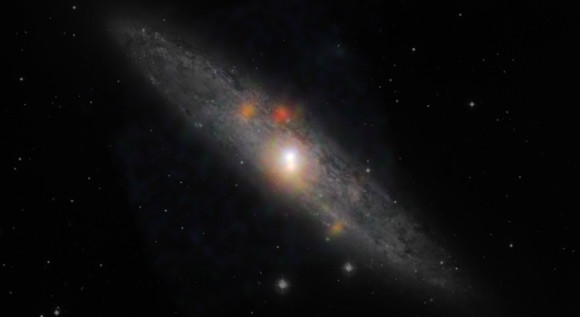A black hole observed nearly a decade ago at the center of the Sculptor galaxy now appears to be sleeping.
in 2003, NASA’s Chandra X-ray Observatory caught signs of what appeared to be a black hole snacking on gas at the middle of the nearby Sculptor galaxy. Now, NASA’s Nuclear Spectroscopic Telescope Array (NuSTAR), which sees higher-energy X-ray light, has taken a peek and found the black hole asleep.

Bret Lehmer, of the Johns Hopkins University and NASA’s Goddard Space Flight Center, is lead author of a study detailing the findings in the Astrophysical Journal. He said:
Our results imply that the black hole went dormant in the past 10 years. Periodic observations with both Chandra and NuSTAR should tell us unambiguously if the black hole wakes up again. If this happens in the next few years, we hope to be watching.
The slumbering black hole is about five million times the mass of our sun. It lies at the center of the Sculptor galaxy, also known as NGC 253, a so-called starburst galaxy actively giving birth to new stars. At 13 million light-years away, this is one of the closest starbursts to our own galaxy, the Milky Way.
The Milky Way is all around more quiet than the Sculptor galaxy. It makes far fewer new stars, and its behemoth black hole, about 4 million times the mass of our sun, is also snoozing.
Ann Hornschemeier of Goddard is co-author of the study. She said:
Black holes feed off surrounding accretion disks of material. When they run out of this fuel, they go dormant. NGC 253 is somewhat unusual because the giant black hole is asleep in the midst of tremendous star-forming activity all around it.
Nearly all galaxies are suspected to harbor supermassive black holes at their hearts. In the most massive of these, the black holes are thought to grow at the same rate that new stars form, until blasting radiation from the black holes ultimately shuts down star formation. In the case of the Sculptor galaxy, astronomers do not know if star formation is winding down or ramping up.
Chandra first observed signs of what appeared to be a feeding supermassive black hole at the heart of the Sculptor galaxy in 2003. As material spirals into a black hole, it heats up to tens of millions of degrees and glows in X-ray light that telescopes like Chandra and NuSTAR can see.
Then, in September and November of 2012, Chandra and NuSTAR observed the same region simultaneously. The NuSTAR observations – the first-to detect focused, high-energy X-ray light from the region – allowed the researchers to say conclusively that the black hole is not accreting material. NuSTAR launched into space in June of 2012.
In other words, the black hole seems to have fallen asleep. Another possibility is that the black hole was not actually awake 10 years ago, and Chandra observed a different source of X-rays. Future observations with both telescopes may solve the puzzle.











